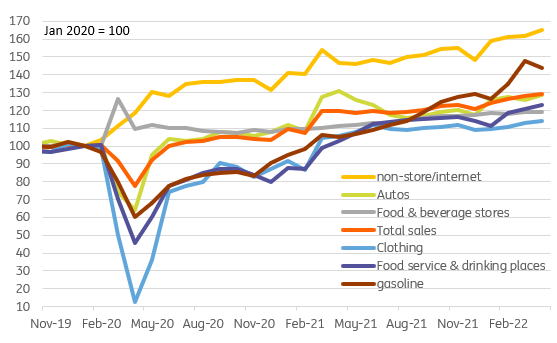Solid US Retail Sales Point To Growth Rebound And More Fed Hikes
The US retail sales report for April is very solid and points to a willingness amongst households to run down accumulated savings to maintain lifestyles at a time when inflation is hurting real income growth.

It fully backs the case for a sharp recovery in GDP growth in the second quarter and a series of 50bp rate hikes from the Federal Reserve.
Households happy to spend
US retail sales rose 0.9% month-on-month in April, not quite as strong as the 1% consensus expectation, but there were substantial upward revisions for March to 1.4% MoM growth from the 0.5% rate initially reported. Moreover, the "core" figures that better match up with broader consumer spending trends were much better than expected. The control group that excludes volatile food, gasoline, food service and building material rose 1% (consensus 0.7%) after a 1.1% increase in March (originally reported as -0.1%).
The details show motor vehicle and parts sales rose 2.2%, which is quite disappointing given unit auto sales data posted a 7.2% MoM rise to 14.29mn in April and prices were significantly higher. Maybe we will see more upward revisions down the line or timing issues may mean they feed through into May’s figure. Gasoline station sales fell 2.7% due to slightly lower prices – remember the retail sales report is a nominal dollar value figure. Food & beverage stores, building materials and sporting goods all saw modest falls, but this was more than offset by a 4% increase in miscellaneous stores, a 2.1% increase in non-store retailers, a 1.1% increase at department stores and a 2% increase in eating and drinking place.
US retail sales performance by component

Source: Macrobond, ING
Households are prepared to run down some savings
This is an impressive outcome given consumer confidence has been hit hard by the fact wages are not keeping pace with the increases in the cost of living. Nonetheless, employment is rising and household wealth has increased substantially during the pandemic thanks to accumulated savings (in part down to huge fiscal support) and soaring asset prices. Today’s report suggests households appear content to run down some of those savings to maintain lifestyles.
People movement has fully recovered after Omicron wave

Source: Macrobond, ING
3%+GDP growth on the cards for 2Q 2022
This is also borne out by data showing big improvement in people movement around retail and recreation areas (see chart above on Google mobility data), surging restaurant dining and recovery in air passenger numbers following the Covid Omicron wave. This gives us more confidence in our second quarter GDP forecast of 3-3.5% annualized growth. In an environment of 3.6% unemployment and 8.3% inflation this supports the case for a series of 50bp rate hikes from the Federal Reserve.
Disclaimer: This publication has been prepared by the Economic and Financial Analysis Division of ING Bank N.V. (“ING”) solely for information purposes without regard to any ...
more


